One interesting fact about the Belgian Malinois is their remarkable intelligence and work ethic. Belgian Malinois is often considered one of the most intelligent dog breeds globally, and they excel in various roles that require problem-solving and agility.
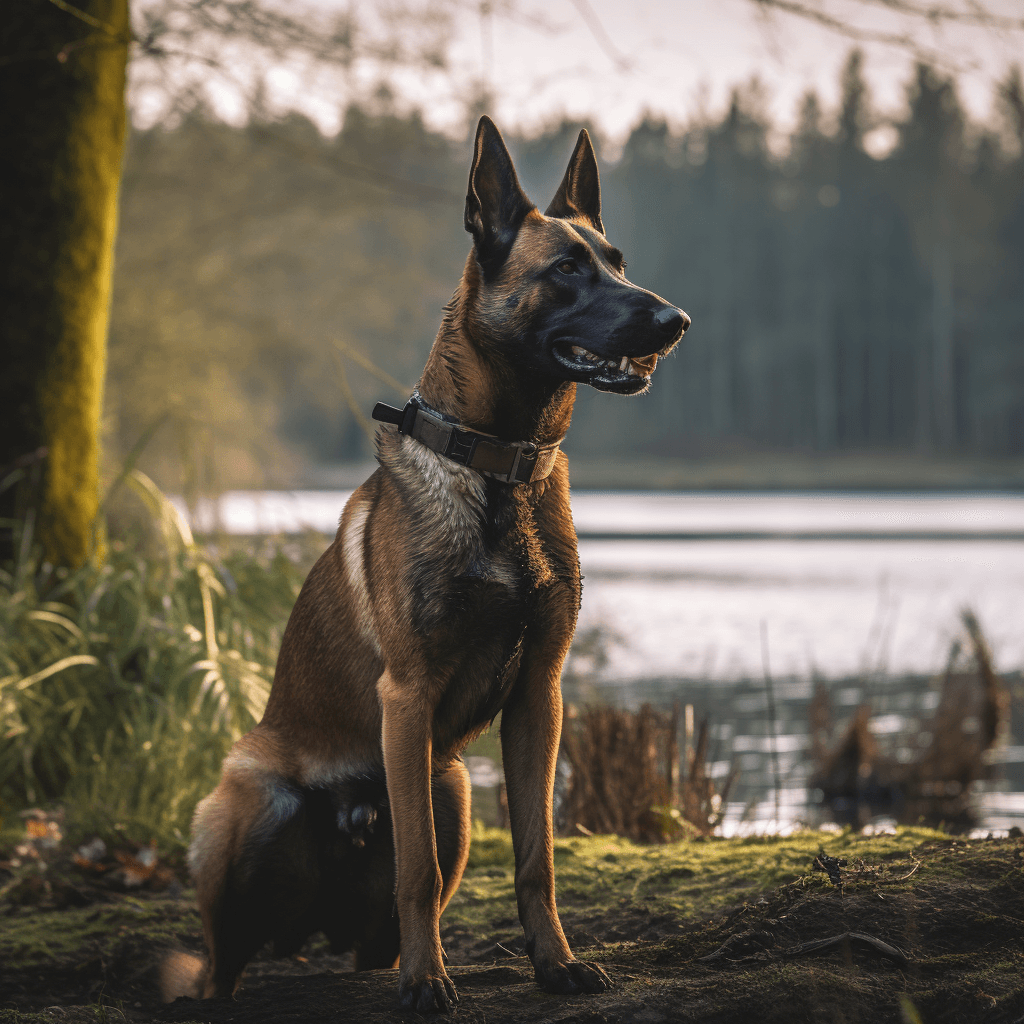
Here are a few more intriguing facts about Belgian Malinois:
- Military and Police Work: Belgian Malinois are frequently used in military and police roles worldwide due to their intelligence, trainability, and bravery. They're known for their ability to perform tasks like search and rescue, drug detection, and apprehension of suspects.
- Herding Background: Originally bred as herding dogs in Belgium, Malinois has a strong work ethic and natural herding instincts. They are agile and excel in dog sports like obedience, agility, and herding trials.
- Athleticism: These dogs are highly athletic and energetic. They need regular exercise and mental stimulation to thrive. Many Malinois owners engage in activities like agility training and Schutzhund to keep them physically and mentally fit.
- Famous in Hollywood: Belgian Malinois have made appearances in popular culture. They've been featured in movies and TV shows, often portraying police or military working dogs due to their impressive abilities.
- Loyal Companions: While known for their working roles, Malinoiss can also make excellent family pets with proper training and socialization. They are dedicated and protective of their families.
- Health and Longevity: Like many purebred dogs, Belgian Malinois can be prone to specific health issues, including hip dysplasia and progressive retinal atrophy. However, with responsible breeding and regular veterinary care, they can live a healthy life with an average lifespan of around 10 to 14 years.
- Search and Rescue Heroes: Belgian Malinois have been involved in numerous search and rescue missions, including natural disasters and missing persons cases. Their keen sense of smell and determination make them valuable assets in these situations.
- Variety in Coat Color: While the most common coat color for Malinois is fawn with a black mask, they can also come in variations like mahogany with a black mask or solid black. Their short, dense coat is low-maintenance.
- Notable Canine Military Heroes: Some Belgian Malinois have gained fame for their heroic actions in the military. One famous example is Cairo, a Malinois who was part of the Navy SEAL team that carried out the mission to capture Osama bin Laden.
- Global Popularity: Belgian Malinois have gained popularity not only in Belgium but also around the world for their versatility and exceptional abilities.
The Belgian Malinois is a breed of dog known for its moderate size, harmonious build, and a combination of elegance and strength. It's a square-shaped dog with a rustic appearance, well-suited for outdoor life and resilient to the atmospheric changes of the Belgian climate.
This breed has a harmonious form with a high head carriage and should give the impression of elegant strength inherited from the selected representatives of a working breed. The Belgian Malinois should be assessed in its natural stance, without physical contact with the handler.
This breed has a harmonious form with a high head carriage and should give the impression of elegant strength inherited from the selected representatives of a working breed. The Belgian Malinois should be assessed in its natural stance, without physical contact with the handler.
Significant Proportions: The Belgian Malinois should appear square, with the chest reaching the elbows and the length of the muzzle being equal to or slightly greater than half the length of the head.
Behavior and Temperament: The Belgian Malinois is an alert and lively dog with explosive energy, always ready for action. It has a natural talent for herding and valuable qualities as a property guard dog. It's an unwavering and zealous protector of its owner. The Belgian Malinois combines all the qualities necessary for herding, guard duty, and service.
Its cheerful, lively temperament and self-assured nature, which doesn't show fear or aggression, should be evident in its stance and the proud, attentive expression in its brilliant eyes.
When judging this breed, consider its calm and fearless character.
Head: The head is held high, moderately long, without exaggeration, well-sculpted, and dry.
Cranial Region: The skull is moderately broad, proportional to the head's length. The forehead is more flat than rounded, and the frontal furrow is not overly pronounced. The lines of the forehead and muzzle are parallel. The occipital crest is slightly developed, and the superciliary and zygomatic arches are not prominent.
Transition from the Forehead to the Muzzle: Moderate.
Nose: Black.
Muzzle: Of moderate length and well-defined under the eyes; gradually narrows towards the nose, similar to an extended wedge; the nose bridge is straight and parallel to the forehead; jaws with a well-defined undershot, meaning that when the jaws are open, the corners of the mouth are pulled straight back, and the jaws are well separated.
Lips: Thin, fit tightly, and well pigmented.
Jaws and Teeth: Strong, white teeth regularly and firmly set in well-developed jaws. Scissor bite: a straight bite, which shepherds prefer, is acceptable. A complete set of teeth according to the dental formula; the absence of the two first premolars (P1) is good, and the third molars (M3) are not considered.
Behavior and Temperament: The Belgian Malinois is an alert and lively dog with explosive energy, always ready for action. It has a natural talent for herding and valuable qualities as a property guard dog. It's an unwavering and zealous protector of its owner. The Belgian Malinois combines all the qualities necessary for herding, guard duty, and service.
Its cheerful, lively temperament and self-assured nature, which doesn't show fear or aggression, should be evident in its stance and the proud, attentive expression in its brilliant eyes.
When judging this breed, consider its calm and fearless character.
Head: The head is held high, moderately long, without exaggeration, well-sculpted, and dry.
Cranial Region: The skull is moderately broad, proportional to the head's length. The forehead is more flat than rounded, and the frontal furrow is not overly pronounced. The lines of the forehead and muzzle are parallel. The occipital crest is slightly developed, and the superciliary and zygomatic arches are not prominent.
Transition from the Forehead to the Muzzle: Moderate.
Nose: Black.
Muzzle: Of moderate length and well-defined under the eyes; gradually narrows towards the nose, similar to an extended wedge; the nose bridge is straight and parallel to the forehead; jaws with a well-defined undershot, meaning that when the jaws are open, the corners of the mouth are pulled straight back, and the jaws are well separated.
Lips: Thin, fit tightly, and well pigmented.
Jaws and Teeth: Strong, white teeth regularly and firmly set in well-developed jaws. Scissor bite: a straight bite, which shepherds prefer, is acceptable. A complete set of teeth according to the dental formula; the absence of the two first premolars (P1) is good, and the third molars (M3) are not considered.
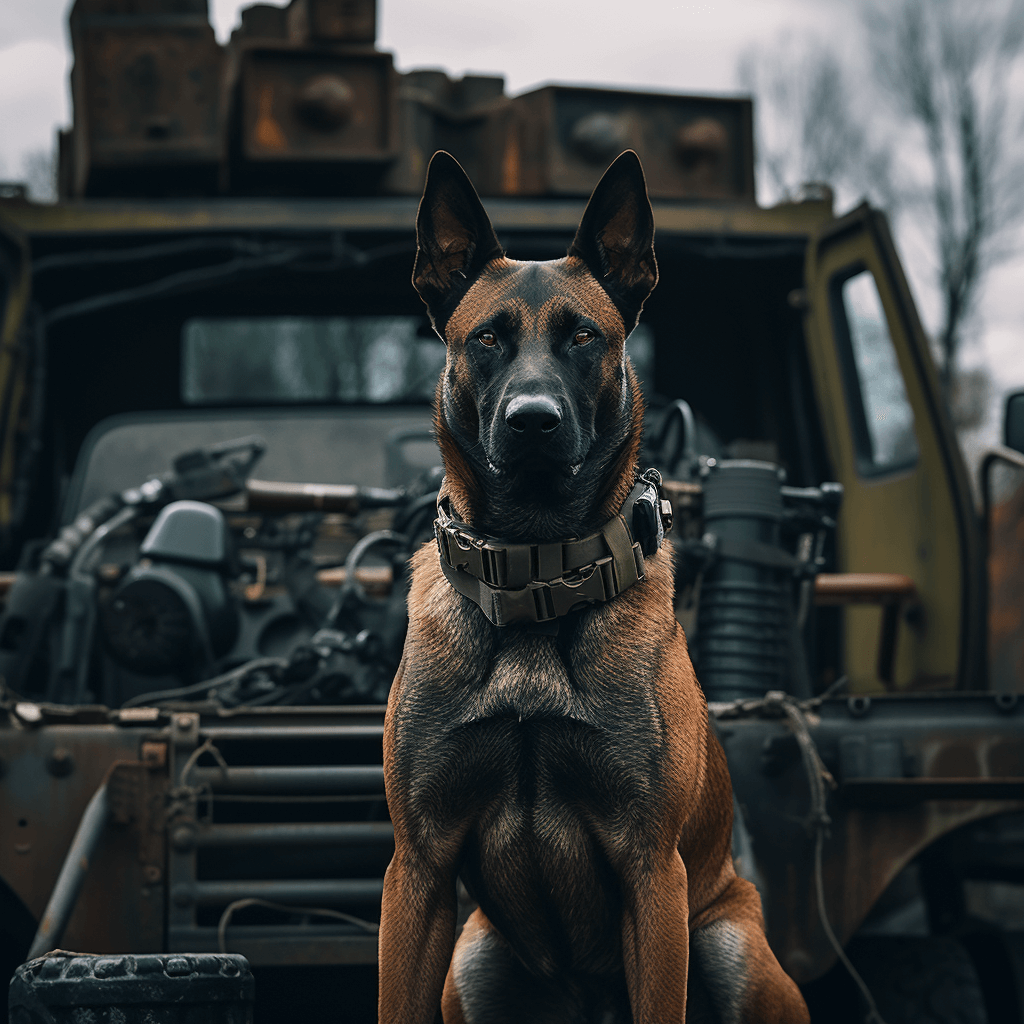
Cheeks: Dry and flat, although muscular.
Eyes: Medium-sized, not protruding or sunken, slightly almond-shaped, slanted, brown in color, predominantly dark; black eyelid rims; open, lively, intelligent, and curious expression.
Ears: Quite small, set high, clearly triangular, with rounded outer ear and pointed tips; ears are stiff, held upright, and vertical when the dog is alert.
Neck: Well set, slightly elongated, relatively vertical, muscular, gradually broadens to the shoulders, without dewlap, with a somewhat arched nape.
Body:
Withers: Pronounced.
Topline: The top line of the back and loin is straight.
Back (from withers to loin): Strong, short, and muscular.
Loin: Muscular, slightly sloping, reasonably broad but not excessively.
Chest: Slightly wide but well let down; the upper part of the ribs is vaulted; when viewed from the front, the front part of the chest is slightly wide but not narrow.
Bottom Line: Starts from the bottom of the chest and gently rises in a harmonious curve to the abdomen, which is not drooping or tucked up but slightly drawn up and moderately developed.
Tail: Well set, strong at the base, of medium length, reaching at least to the hock joint but usually longer; at rest, it is lowered with the tip directed back at the level of the hock joint; in motion, it is carried without crossing the horizontal line, with a slight accentuation of the curve at the end of the tail without forming a hook or kink, in any condition.
FRONT PART
General Appearance: The skeleton is firm but not coarse; the musculature is dry and robust; the front legs are vertical from all sides and perfectly parallel when viewed from the front.
Shoulders: Long and slanting, well-attached, forming an adequate angle with the upper arm bones, ideally 110-115 degrees.
Upper Arm Bones: Long and moderately slanting.
Elbows: Strong, not turned out, not pushed under.
Forearms: Long and straight.
Wrists: Powerful and dry.
Pasterns: Strong and short, perpendicular to the ground as much as possible or only slightly sloping.
Feet: Round, cat-like feet; arched toes and pads are filled and elastic; nails are dark and robust.
REAR PART
General Appearance: Strong but not coarse; in profile, the hind legs are vertical and perfectly parallel when viewed from the rear.
Thighs: Of moderate length, broad, and very muscular.
Knees: Approximately straight from the hock joint; standard knee angles.
Lower Legs: Of moderate length, broad, and muscular.
Hock Joints: Wide and muscular, with moderate joint angles.
Metatarsi: Strong and short; turned feet are not desirable.
Feet: May be slightly oval; arched toes and pads are filled and elastic; nails are dark and robust.
Movement: Fast and free movements in all gaits; the Belgian Malinois trots nicely, but its normal gaits are the pace and especially the gallop; the legs move parallel to the median plane of the body. At high speed, the legs approach the median plane; in a trot, the stride is moderate, the movements are even and light, with a reasonable drive from behind, and the top line remains firm while the front legs do not lift too high. The Belgian Malinois always looks tireless in motion; its movements are stable, elastic, and fast. It is capable of sudden direction changes at full speed. Due to its boisterous temperament and passion for guarding and protecting, it is prone to move in circles.
SKIN: Elastic but tightly fitting all over the body; the edges of the lips and eyelids are intensely pigmented.
VARIETIES BASED ON COAT AND COLORS: Since among Belgian Shepherds, the coat is distinguished by length, direction, type, and color, this article is adopted as a criterion for determining the differences between the four varieties of the breed: Groenendael, Tervuren, Malinois, and Laekenois.
These four varieties are assessed separately, and each can receive CAC, CACIB, or reserve titles.
Eyes: Medium-sized, not protruding or sunken, slightly almond-shaped, slanted, brown in color, predominantly dark; black eyelid rims; open, lively, intelligent, and curious expression.
Ears: Quite small, set high, clearly triangular, with rounded outer ear and pointed tips; ears are stiff, held upright, and vertical when the dog is alert.
Neck: Well set, slightly elongated, relatively vertical, muscular, gradually broadens to the shoulders, without dewlap, with a somewhat arched nape.
Body:
Withers: Pronounced.
Topline: The top line of the back and loin is straight.
Back (from withers to loin): Strong, short, and muscular.
Loin: Muscular, slightly sloping, reasonably broad but not excessively.
Chest: Slightly wide but well let down; the upper part of the ribs is vaulted; when viewed from the front, the front part of the chest is slightly wide but not narrow.
Bottom Line: Starts from the bottom of the chest and gently rises in a harmonious curve to the abdomen, which is not drooping or tucked up but slightly drawn up and moderately developed.
Tail: Well set, strong at the base, of medium length, reaching at least to the hock joint but usually longer; at rest, it is lowered with the tip directed back at the level of the hock joint; in motion, it is carried without crossing the horizontal line, with a slight accentuation of the curve at the end of the tail without forming a hook or kink, in any condition.
FRONT PART
General Appearance: The skeleton is firm but not coarse; the musculature is dry and robust; the front legs are vertical from all sides and perfectly parallel when viewed from the front.
Shoulders: Long and slanting, well-attached, forming an adequate angle with the upper arm bones, ideally 110-115 degrees.
Upper Arm Bones: Long and moderately slanting.
Elbows: Strong, not turned out, not pushed under.
Forearms: Long and straight.
Wrists: Powerful and dry.
Pasterns: Strong and short, perpendicular to the ground as much as possible or only slightly sloping.
Feet: Round, cat-like feet; arched toes and pads are filled and elastic; nails are dark and robust.
REAR PART
General Appearance: Strong but not coarse; in profile, the hind legs are vertical and perfectly parallel when viewed from the rear.
Thighs: Of moderate length, broad, and very muscular.
Knees: Approximately straight from the hock joint; standard knee angles.
Lower Legs: Of moderate length, broad, and muscular.
Hock Joints: Wide and muscular, with moderate joint angles.
Metatarsi: Strong and short; turned feet are not desirable.
Feet: May be slightly oval; arched toes and pads are filled and elastic; nails are dark and robust.
Movement: Fast and free movements in all gaits; the Belgian Malinois trots nicely, but its normal gaits are the pace and especially the gallop; the legs move parallel to the median plane of the body. At high speed, the legs approach the median plane; in a trot, the stride is moderate, the movements are even and light, with a reasonable drive from behind, and the top line remains firm while the front legs do not lift too high. The Belgian Malinois always looks tireless in motion; its movements are stable, elastic, and fast. It is capable of sudden direction changes at full speed. Due to its boisterous temperament and passion for guarding and protecting, it is prone to move in circles.
SKIN: Elastic but tightly fitting all over the body; the edges of the lips and eyelids are intensely pigmented.
VARIETIES BASED ON COAT AND COLORS: Since among Belgian Shepherds, the coat is distinguished by length, direction, type, and color, this article is adopted as a criterion for determining the differences between the four varieties of the breed: Groenendael, Tervuren, Malinois, and Laekenois.
These four varieties are assessed separately, and each can receive CAC, CACIB, or reserve titles.
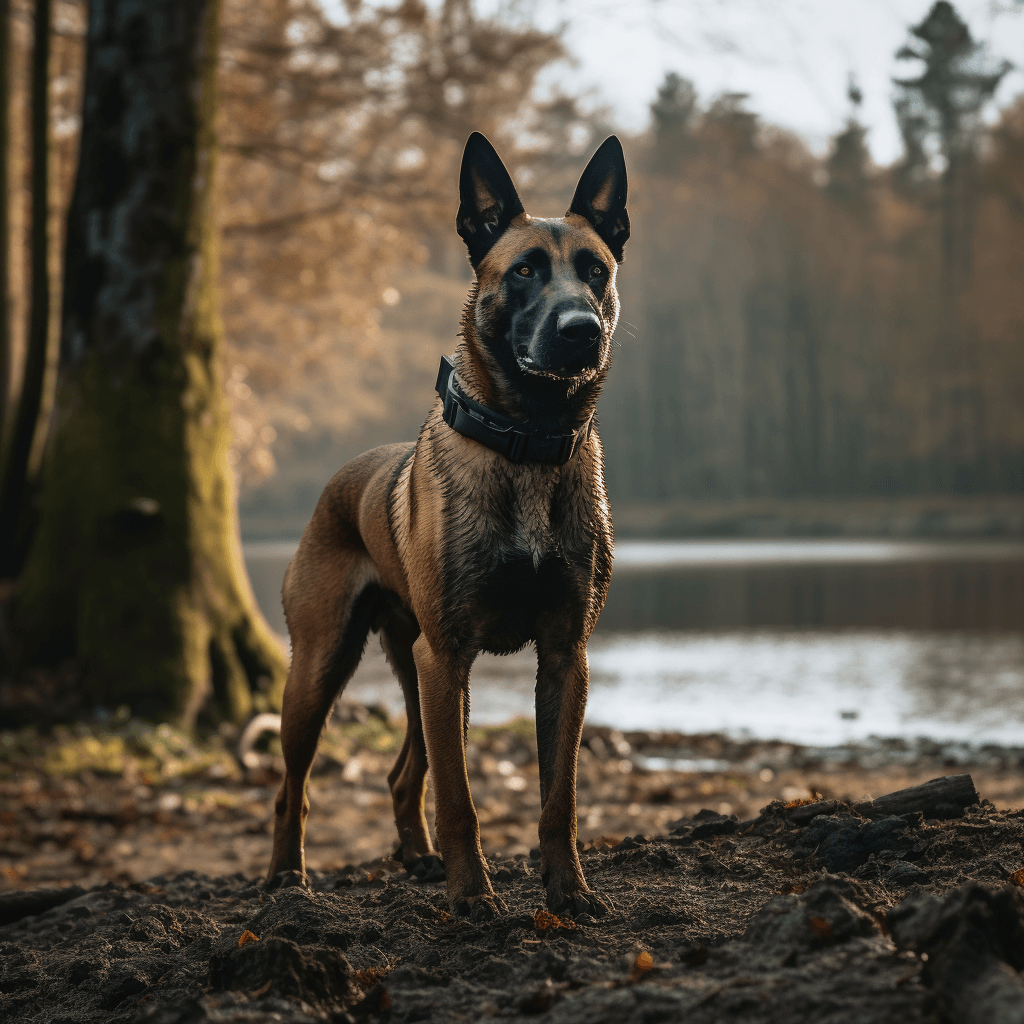
COAT:
In all varieties, the coat should always be dense, tightly fitting, and of optimal structure, with a fluffy undercoat that creates an excellent protective covering.
A. LONG COAT: The coat is short on the head, the outer sides of the ears, and the lower part of the limbs, excluding the rear side of the forelimbs, which is covered from the elbows to the wrists with long hair called "culottes." The coat is long and smooth on the rest of the body, longer and denser around the neck and on the front of the chest, forming a mane or collar and a bib. When outdoors, the dog is protected by dense tufts of hair. Near the base of the ears, the hair stands perpendicular to the skin's surface, framing the head. The back of the thighs is covered with very long, dense hair, forming breeches or culottes. The tail is adorned with long, luxuriant hair, creating a plume.
Groenendael and Tervuren have long coats.
B. SHORT COAT: The hair is concise on the head, the ears' outer sides, and the limbs' lower parts. It is short on the rest of the body and denser on the tail and around the neck, forming a mane or collar that begins at the base of the ears and extends along the throat. The back of the thighs is also framed with longer hair. The tail, in shape, resembles an ear of corn but does not form a plume.
Malinois has a short coat.
C. ROUGH (BRUSHED) COAT: What particularly distinguishes the rough variety is the coarseness and dryness of the coat, which also rustles and is tousled. The length is approximately 6 cm all over the body, with shorter hair on the nose, forehead, and legs. The hair around the eyes and on the face should not be so long as to conceal the head's shape. However, decorative hair on the face is a significant advantage. The tail should not have a plume.
Laekenois has a rough (brushed) coat.
COLOR:
Mask: In Tervuren and Malinois, the mask should be strongly pronounced and extended to cover the upper and lower lips, the corners of the lips, and the eyelids in a single black area. A minimum of six places of skin pigmentation is required: two ears, two upper eyelids, and two lips, both upper and lower, all of which must be black.
Black Overlay: In Tervuren and Malinois, a black overlay means the hair has black tips that shade the primary color. This black should not appear as large spots or definite stripes (tiger) and should always be accompanied by red. In Laekenois, the black overlay is expressed more modestly.
Groenendael: Only a solid black color.
Tervuren: Only fawn with black or gray with black, with a black mask; however, fawn with black is preferred. The fawn should be rich, not light or diluted. Any dog whose color is far from being intensely fawned with black cannot be considered an elite specimen.
Malinois: Only fawn with black and a fawn mask.
Laekenois: Only fawn with traces of black, mainly on the face and tail.
For all varieties: a tolerable small amount of white on the chest and toes.
Height at the Withers:
Ideal height at the withers on average:
24.4 inches for males,
22.8 inches for females.
Allowable range: up to 0.8 inches lower or 1.6 inches higher.
Weight:
Males around 55-66 lbs.
Females around 44-55 lbs.
Measurements:
Average values of standard measurements for an adult Belgian Shepherd with a height at the withers of 24.4 inches:
Body length (from the shoulder-blade joint protrusion to the tailbone): 24.4 inches.
Head length: 9.8 inches.
Muzzle length: 4.9 - 5.1 inches.
Defects: Any deviation from the above points should be considered a defect, and the evaluation should be in direct proportion to the degree of the deviation.
In all varieties, the coat should always be dense, tightly fitting, and of optimal structure, with a fluffy undercoat that creates an excellent protective covering.
A. LONG COAT: The coat is short on the head, the outer sides of the ears, and the lower part of the limbs, excluding the rear side of the forelimbs, which is covered from the elbows to the wrists with long hair called "culottes." The coat is long and smooth on the rest of the body, longer and denser around the neck and on the front of the chest, forming a mane or collar and a bib. When outdoors, the dog is protected by dense tufts of hair. Near the base of the ears, the hair stands perpendicular to the skin's surface, framing the head. The back of the thighs is covered with very long, dense hair, forming breeches or culottes. The tail is adorned with long, luxuriant hair, creating a plume.
Groenendael and Tervuren have long coats.
B. SHORT COAT: The hair is concise on the head, the ears' outer sides, and the limbs' lower parts. It is short on the rest of the body and denser on the tail and around the neck, forming a mane or collar that begins at the base of the ears and extends along the throat. The back of the thighs is also framed with longer hair. The tail, in shape, resembles an ear of corn but does not form a plume.
Malinois has a short coat.
C. ROUGH (BRUSHED) COAT: What particularly distinguishes the rough variety is the coarseness and dryness of the coat, which also rustles and is tousled. The length is approximately 6 cm all over the body, with shorter hair on the nose, forehead, and legs. The hair around the eyes and on the face should not be so long as to conceal the head's shape. However, decorative hair on the face is a significant advantage. The tail should not have a plume.
Laekenois has a rough (brushed) coat.
COLOR:
Mask: In Tervuren and Malinois, the mask should be strongly pronounced and extended to cover the upper and lower lips, the corners of the lips, and the eyelids in a single black area. A minimum of six places of skin pigmentation is required: two ears, two upper eyelids, and two lips, both upper and lower, all of which must be black.
Black Overlay: In Tervuren and Malinois, a black overlay means the hair has black tips that shade the primary color. This black should not appear as large spots or definite stripes (tiger) and should always be accompanied by red. In Laekenois, the black overlay is expressed more modestly.
Groenendael: Only a solid black color.
Tervuren: Only fawn with black or gray with black, with a black mask; however, fawn with black is preferred. The fawn should be rich, not light or diluted. Any dog whose color is far from being intensely fawned with black cannot be considered an elite specimen.
Malinois: Only fawn with black and a fawn mask.
Laekenois: Only fawn with traces of black, mainly on the face and tail.
For all varieties: a tolerable small amount of white on the chest and toes.
Height at the Withers:
Ideal height at the withers on average:
24.4 inches for males,
22.8 inches for females.
Allowable range: up to 0.8 inches lower or 1.6 inches higher.
Weight:
Males around 55-66 lbs.
Females around 44-55 lbs.
Measurements:
Average values of standard measurements for an adult Belgian Shepherd with a height at the withers of 24.4 inches:
Body length (from the shoulder-blade joint protrusion to the tailbone): 24.4 inches.
Head length: 9.8 inches.
Muzzle length: 4.9 - 5.1 inches.
Defects: Any deviation from the above points should be considered a defect, and the evaluation should be in direct proportion to the degree of the deviation.
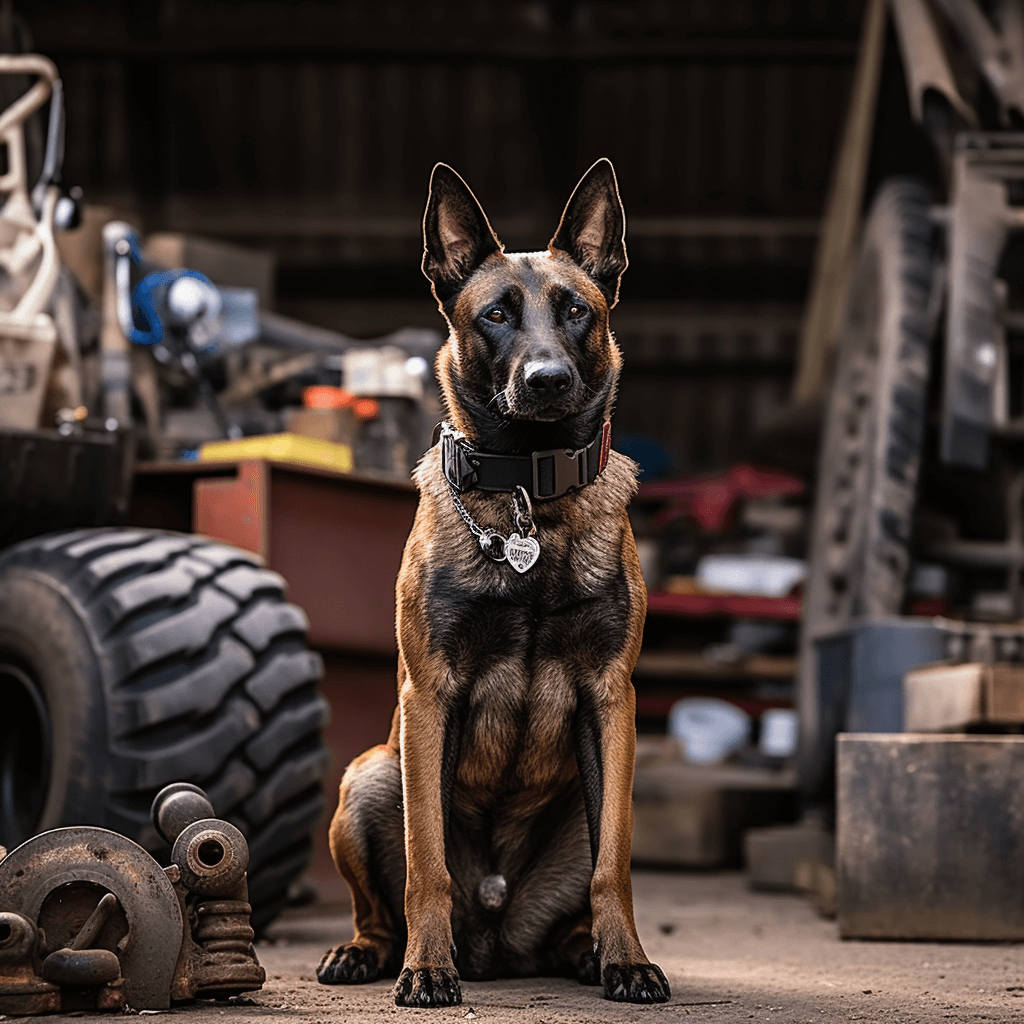
General Appearance:
Clumsiness, lack of elegance; too light or weak; stretched format.
Head: Coarse, very massive, non-parallel lines of the forehead and muzzle; poorly defined and dry head; too round a forehead; the transition from the forehead to the muzzle is too pronounced or too smoothed; a short or tiny muzzle; hump nose; prominent eyebrows or cheekbones.
Nose, Lips, and Eyelids: Signs of depigmentation.
Teeth: Non-linear arrangement of incisors. Serious defect: absence of one incisor, one-second premolar (1P2), one-third premolar (1P3), or three first premolars (3P1).
Eyes: Light, round.
Ears: Large, long, too wide at the base, low-set, hanging, or oriented towards each other.
Neck: Thin; short or low-set.
Withers: Flat, low.
Topline: Back or loins long, weak, sagging, or tense.
Croup: Sloped, high-set.
Bottom Line: Too deep or not profound enough; paunch.
Tail: Set very low; held too high, forming a hook or twist.
Limbs: Skeleton too light or very coarse; non-vertical placement in profile (i.e., pasterns too sloping or weak wrists), in front (knuckling over or out at the elbows, etc.), or in the rear (too narrow or very wide-set hind limbs, barrel-shaped stance, hocks close together or turned out, etc.); straightness or sableness.
Feet: Flat or splayed.
Movement: Not free; short step, feeble push, poor transmission through the topline, high lift of legs.
Coat: For all varieties - insufficient undercoat.
Groenendael and Tervuren: Fluffy, wavy, curly coat; not long enough.
Malinois: Coat extended where it should be short; Smooth coat; stiff hairs scattered in the short coat; wavy coat.
Laekenois: Very long, silky, wavy, curly, or short coat; saturated with fine hairs scattered in strands of coarse wool; too long hair around the eyes or chin; fluffy tail.
Color: A white mark on the chest forms a tie for all varieties, and white on the toes extends beyond the toes.
Groenendael: Rust-colored shades in the coat; gray pants.
Tervuren: Gray.
Tervuren and Malinois: Brindle; a tone that is not warm enough; too little or too much black or black forms spots on the body; lack of a mask.
Tervuren, Malinois, and Laekenois: Too light fawn color; a base color that is significantly diluted, considered a severe defect.
Temperament: Individuals with insufficient self-confidence or excessive nervousness.
Clumsiness, lack of elegance; too light or weak; stretched format.
Head: Coarse, very massive, non-parallel lines of the forehead and muzzle; poorly defined and dry head; too round a forehead; the transition from the forehead to the muzzle is too pronounced or too smoothed; a short or tiny muzzle; hump nose; prominent eyebrows or cheekbones.
Nose, Lips, and Eyelids: Signs of depigmentation.
Teeth: Non-linear arrangement of incisors. Serious defect: absence of one incisor, one-second premolar (1P2), one-third premolar (1P3), or three first premolars (3P1).
Eyes: Light, round.
Ears: Large, long, too wide at the base, low-set, hanging, or oriented towards each other.
Neck: Thin; short or low-set.
Withers: Flat, low.
Topline: Back or loins long, weak, sagging, or tense.
Croup: Sloped, high-set.
Bottom Line: Too deep or not profound enough; paunch.
Tail: Set very low; held too high, forming a hook or twist.
Limbs: Skeleton too light or very coarse; non-vertical placement in profile (i.e., pasterns too sloping or weak wrists), in front (knuckling over or out at the elbows, etc.), or in the rear (too narrow or very wide-set hind limbs, barrel-shaped stance, hocks close together or turned out, etc.); straightness or sableness.
Feet: Flat or splayed.
Movement: Not free; short step, feeble push, poor transmission through the topline, high lift of legs.
Coat: For all varieties - insufficient undercoat.
Groenendael and Tervuren: Fluffy, wavy, curly coat; not long enough.
Malinois: Coat extended where it should be short; Smooth coat; stiff hairs scattered in the short coat; wavy coat.
Laekenois: Very long, silky, wavy, curly, or short coat; saturated with fine hairs scattered in strands of coarse wool; too long hair around the eyes or chin; fluffy tail.
Color: A white mark on the chest forms a tie for all varieties, and white on the toes extends beyond the toes.
Groenendael: Rust-colored shades in the coat; gray pants.
Tervuren: Gray.
Tervuren and Malinois: Brindle; a tone that is not warm enough; too little or too much black or black forms spots on the body; lack of a mask.
Tervuren, Malinois, and Laekenois: Too light fawn color; a base color that is significantly diluted, considered a severe defect.
Temperament: Individuals with insufficient self-confidence or excessive nervousness.
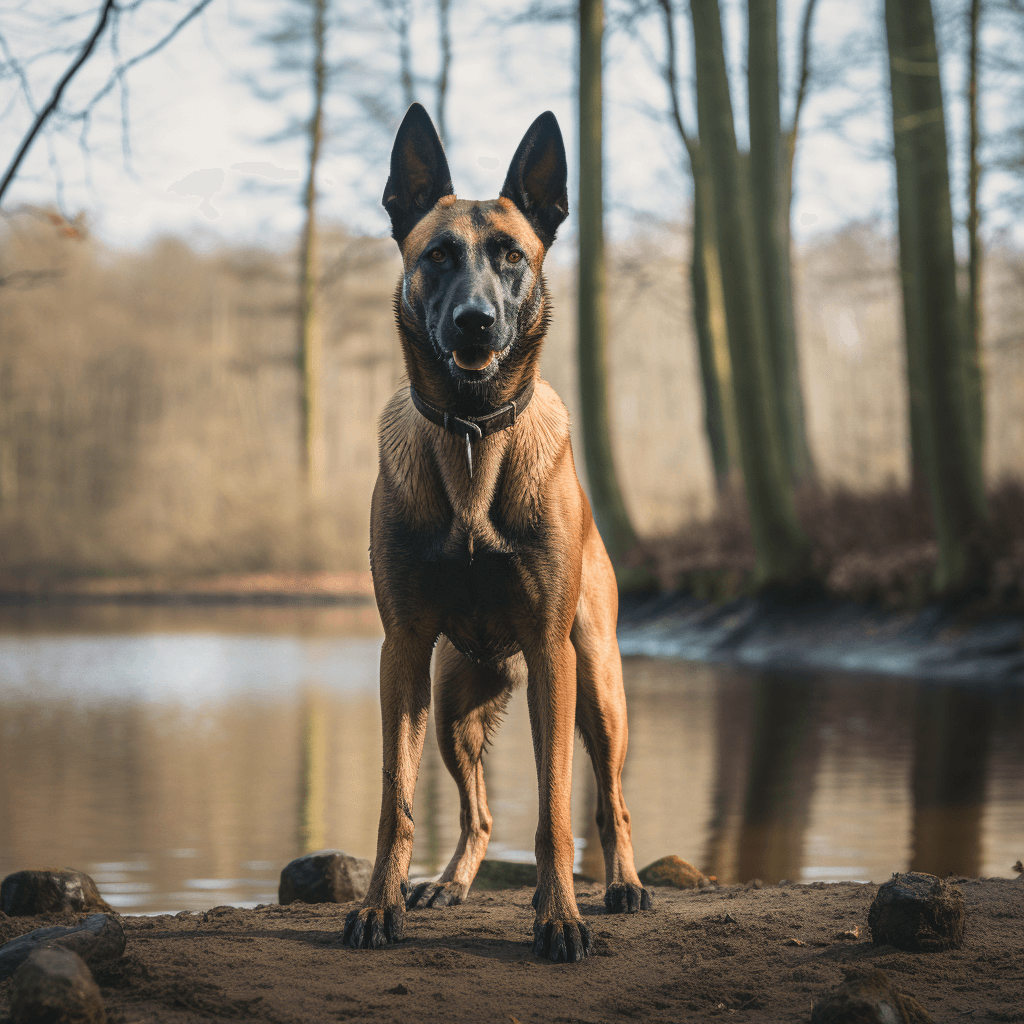
DISQUALIFYING FAULTS:
Behavior: Aggressive or overly timid individuals.
General Appearance: Lack of breed type.
Teeth: Undershot; overshot, even if contact is not lost (reverse scissors bite); jaw skew; absence of one canine, one carnassial tooth (upper P4 or lower M1), one molar (M1 or M2; M3 not included in the count), one-third premolar (P3) plus one other tooth or three teeth (except for first premolars) or more.
Nose, Lips, Eyelids: Strongly pronounced depigmentation.
Ears: Hanging or artificially held erect.
Tail: Absent or docked, naturally or surgically; held very high, forming a ring or curl.
Coat: Absence of undercoat.
Color: Any color that does not correspond to the described varieties; overly extensive white markings on the front of the chest, especially if they reach the neck; white color on the paws more than halfway up the front or rear, forming "socks"; lack of a mask, including on the face, lighter than the entire body, for Tervurens and Malinois.
Height: Exceeds the specified limits.
NOTE: Dogs should have two normal testicles fully descended into the scrotum.
Behavior: Aggressive or overly timid individuals.
General Appearance: Lack of breed type.
Teeth: Undershot; overshot, even if contact is not lost (reverse scissors bite); jaw skew; absence of one canine, one carnassial tooth (upper P4 or lower M1), one molar (M1 or M2; M3 not included in the count), one-third premolar (P3) plus one other tooth or three teeth (except for first premolars) or more.
Nose, Lips, Eyelids: Strongly pronounced depigmentation.
Ears: Hanging or artificially held erect.
Tail: Absent or docked, naturally or surgically; held very high, forming a ring or curl.
Coat: Absence of undercoat.
Color: Any color that does not correspond to the described varieties; overly extensive white markings on the front of the chest, especially if they reach the neck; white color on the paws more than halfway up the front or rear, forming "socks"; lack of a mask, including on the face, lighter than the entire body, for Tervurens and Malinois.
Height: Exceeds the specified limits.
NOTE: Dogs should have two normal testicles fully descended into the scrotum.